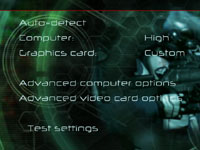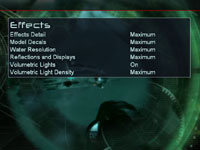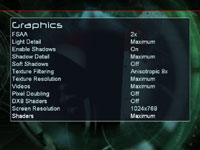
F.E.A.R.
Publisher: VU GamesWe used the full retail version of F.E.A.R. patched to version 1.04. The game makes use of a lot of effects - including soft shadows, volumetric lighting, parallax mapping and particle effects, along with a slow-motion mode that really taxes today's top of the line GPU's. There's extensive use of high resolution textures. The walls are both bump mapped and parallax mapped to give a realistic feel to the brick walls that are a big feature of this title. Also, the world is incredibly destructible, which is made more realistic by parallax mapping.
In general, this is a graphically intense game and the most outstanding part of the graphics engine is undoubtedly the player character's shadow that is cast on the wall.
It also has the most advanced A.I. that we have ever seen in a game engine to date - there are times when you'll find yourself with your pants down around your ankles with no where to go. For anyone who hasn't bought this game yet, we highly recommend you do - check out our full review here.
We did a manual run-through from the "Heavy Resistance" level, between two save game checkpoints - it was a section of intense outdoor gameplay that lasted around three and a half minutes. We recorded frame over time graphs for all of our manual run-throughs because we found that the SloMo mode dropped our frame rates in to the low teens. We suspect this drop is part of Monolith's technique for slowing down the gameplay, as the game was not as jerky as the frame rate suggests.
Antialiasing and anisotropic filtering were controlled from inside the game, and thus drivers were left set to "Application Controlled".


The gameplay experience was smoother, though. We saw an increase of five frames per second on the average frame rate, while the minimum frame rate remained the same at 16 frames per second. With SLI8xAA enabled, we were seeing an average frame rate of less than 30 frames per second in our manual run through.


The BFG Tech GeForce 7900 GTX OC SLI configuration performed well in one of the most intense games on the market at the moment. We were able to play the game very smoothly at the Dell 3007WFP's native 2560x1600 resolution with 0xAA 16xAF and maximum in-game details. The game does benefit from antialiasing, but the aliasing became less apparent at such a high resolution.

MSI MPG Velox 100R Chassis Review
October 14 2021 | 15:04











Want to comment? Please log in.